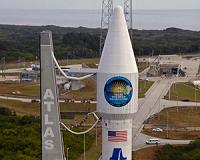 |
Cape Canaveral, Florida (AFP) Feb 11, 2010 NASA launched a first-of-its-kind solar observatory into space Thursday in hopes of expanding scientists' understanding of the sun and its complicated workings. A two-stage Atlas rocket roared off its launch pad from the Kennedy Space Center in Cape Canaveral, Florida at 10:23 am (1523 GMT), carrying NASA's Solar Dynamic Observatory (SDO) into space. NASA said the solar probe successfully separated from the booster rocket about one hour and 48 minutes after the launch. NASA missed its first launch opportunity on Wednesday because of high winds, but the weather cooperated Thursday despite partially cloudy skies. The 3.2-tonne satellite was to be lofted into orbit some 22,295 miles (35,880 kilometers) from Earth, circling the planet once every 24 hours during its five-year mission. "This is going to be sensational," said Richard Fisher, director of the Heliophysics Division at NASA Headquarters in Washington. "SDO is going to make a huge step forward in our understanding of the sun and its effects on life and society." Space physicists have called SDO the cornerstone of future NASA missions to study the sun, which is considered the next frontier for US space research. NASA said the probe will be especially helpful in revealing how changes in the sun alter the levels of radiation and energy within our solar system, and will provide new information concerning the sun and solar system that directly affect Earth, its inhabitants and technology. Scientists said space weather caused by the sun can affect communications and satellite signals, electrical power lines and other objects and energy transmissions in our atmosphere and beyond. Telescopes and other gear onboard the probe will scrutinize sunspots and solar flares using more pixels and colors than any other observatory in the history of solar physics. NASA said the spacecraft will send about 1.5 terabytes of data back to Earth each day -- the equivalent of streaming 380 full-length movies. US physicists said that if they can get a better understanding of the sun's magnetic field, they can predict how it affects the solar system and near-Earth space to create space weather. Among the questions researchers hope to answer is how the sun's magnetic field is generated and how stored magnetic energy changes into kinetic energy, in the form of solar wind and energy particles.
Share This Article With Planet Earth
Related Links Launch Pad at Space-Travel.com
 Solar Dynamics Observatory At Launch Pad
Solar Dynamics Observatory At Launch PadCape Canaveral FL (SPX) Feb 10, 2010 The Solar Dynamics Observatory and its Atlas V rocket rolled out to the launch pad at Launch Complex 41 at Cape Canaveral Air Force Station in Florida. The Tuesday morning move sets the stage for a liftoff Wednesday at 10:26 a.m. EST. Weather for launch day stands at 40 percent "go" at liftoff time due to wind, cloud thickness and a slight chance of showers. The temperature at launch time ... read more |
|
| The content herein, unless otherwise known to be public domain, are Copyright 1995-2010 - SpaceDaily. AFP and UPI Wire Stories are copyright Agence France-Presse and United Press International. ESA Portal Reports are copyright European Space Agency. All NASA sourced material is public domain. Additional copyrights may apply in whole or part to other bona fide parties. Advertising does not imply endorsement,agreement or approval of any opinions, statements or information provided by SpaceDaily on any Web page published or hosted by SpaceDaily. Privacy Statement |